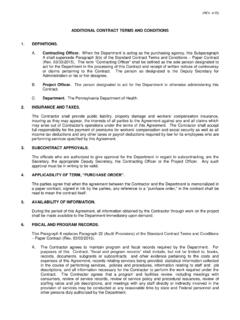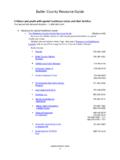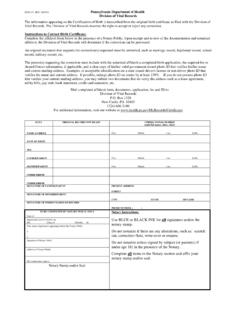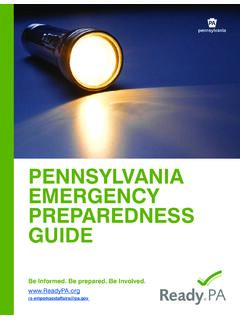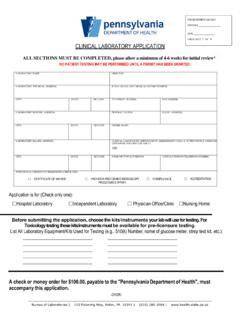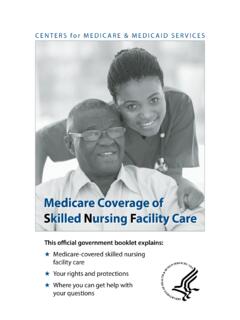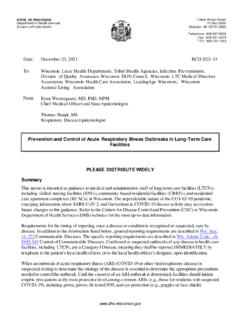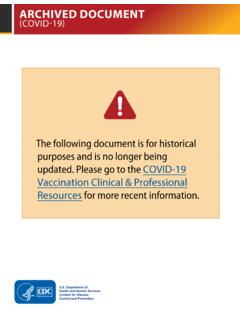Transcription of PENNSYLVANIA DEPARTMENT OF HEALTH 2021 PAHAN 599 …
1 This document has been archived. Please refer to PA-HAN-610 for updated PENNSYLVANIA DEPARTMENT OF HEALTH information on the topic. 2021 PAHAN 599 09-24-UPD. UPDATE: Response to an Outbreak and Residents with Exposure to COVID-19 for long -term care Facilities DATE: 09/24/21. TO: HEALTH Alert Network FROM: Alison Beam, JD, Acting Secretary of HEALTH SUBJECT: UPDATE: Response to an Outbreak and Residents with Exposure to COVID- 19 for long -term care Facilities DISTRIBUTION: Statewide LOCATION: n/a STREET ADDRESS: n/a COUNTY: n/a MUNICIPALITY: n/a ZIP CODE: n/a This transmission is a HEALTH Update: provides updated information regarding an incident or situation; unlikely to require immediate action.
2 HOSPITALS: PLEASE SHARE WITH ALL MEDICAL, PEDIATRIC, NURSING AND LABORATORY STAFF IN YOUR. HOSPITAL; EMS COUNCILS: PLEASE DISTRIBUTE AS APPROPRIATE; FQHCs: PLEASE DISTRIBUTE AS. APPROPRIATE LOCAL HEALTH JURISDICTIONS: PLEASE DISTRIBUTE AS APPROPRIATE; PROFESSIONAL. ORGANIZATIONS: PLEASE DISTRIBUTE TO YOUR MEMBERSHIP; long -TERM care FACILITIES: PLEASE. SHARE WITH ALL MEDICAL, INFECTION CONTROL, AND NURSING STAFF. This guidance has been updated to incorporate changes made by CDC on September 10, 2021. This guidance is designed to supplement the core measures outlined in PA-HAN-568 with additional information to outline the facility 's response to a new suspected, probable, or confirmed case of COVID- 19 in facility healthcare personnel (HCP) or a resident, or when a resident has been exposed to COVID- 19.
3 Key changes include: Outbreak response options are presented including a contact tracing approach or a unit-based or facility -wide approach. Removed quarantine recommendations for fully vaccinated residents who have had close contact with someone with SARS-CoV-2 infection, in most circumstances. An emphasis remains on testing and source control for these patients for 14 days following exposure. Clarification of the recommended intervals for testing asymptomatic residents following exposure to someone with SARS-CoV-2 infection. Removed discussion of Zones for cohorting of residents by exposure status. Cohorting will have limited applications under the new guidance .
4 This guidance supersedes PA-HAN-570. Changes have been noted in red. If you have additional questions about this guidance or would benefit from discussion to support infection prevention and control decisions in your facility , please contact DOH at 1-877-PA- HEALTH (1-877-724-3258) or your local HEALTH DEPARTMENT . Page 1 of 10 Update #570. This guidance is specific for long -term care facilities (LTCF) but may also be applicable to other congregate and residential settings. This guidance replaces PA-HAN-570. Even as nursing homes resume more normal practices and begin relaxing restrictions, nursing homes must sustain core IPC.
5 Practices and remain vigilant for SARS-CoV-2 infection among residents and HCP to prevent spread and protect residents and HCP from severe infections, hospitalizations, and death. Core prevention measures for LTCFs are outlined separately in PA-HAN-568 and should be reviewed closely. This guidance is designed to supplement the core measures with additional information to outline the facility 's response to a new suspected, probable, or confirmed case of COVID-19 in facility HCP or a resident, or when a resident has been exposed to COVID-19. The guidance contains the following sections: 1. Key definitions 2. New resident admissions 3.
6 Residents who leave the facility for medical or social reasons 4. Residents or HCP with signs and symptoms of COVID-19. 5. Identification of exposure to residents 6. Managing residents with exposure 7. Testing residents for SARS-CoV-2. 8. Response to an outbreak of COVID-19. 9. Comment on the use of zones 1. KEY DEFINITIONS. Close contact: Someone who was within 6 feet of an infected person for a cumulative total of 15. minutes or more over a 24-hour period, during their infectious period. The infectious period begins from 2 days before illness onset (or, for asymptomatic patients, 2 days prior to specimen collection date of the positive test).
7 Healthcare personnel (HCP): Include, but are not limited to, emergency medical service personnel, nurses, nursing assistants, physicians, technicians, therapists, phlebotomists, pharmacists, students and trainees, other HCP providing direct care , contractual HCP not employed by the healthcare facility , and persons not directly involved in patient care but who could be exposed to infectious agents that can be transmitted in the healthcare setting ( , clerical, dietary, environmental services, laundry, security, engineering and facilities management, administrative, billing, and volunteer personnel). Immunocompromised: For the purposes of this guidance , moderate to severely immunocompromising conditions include, but might not be limited to, those defined in the CDC Interim Clinical Considerations for Use of COVID-19 Vaccines.
8 Other factors, such as end-stage renal disease, may pose a lower degree of immunocompromise and not clearly affect decisions about need for or duration of Transmission-Based Precautions if the individual had close contact with someone with SARS-CoV-2 infection. However, fully vaccinated people in this category should consider continuing to practice physical distancing and use of source control while in a healthcare facility , even when not otherwise recommended for fully vaccinated individuals. Ultimately, the degree of immunocompromise for the patient is determined by the treating provider, and preventive actions are tailored to each individual and situation.
9 Isolation for residents: The term isolation refers to the implementation of measures for a resident with COVID-19 infection during their infectious period, to prevent transmission to other residents, HCP, or visitors. Isolation in LTCF residents includes: Use of standard and transmission-based precautions for COVID-19; and Page 2 of 10 Update #570. Private room with a private bathroom or with another resident with laboratory- confirmed COVID-19, preferably in a COVID care Unit; and Restrict the resident to their room with the door closed. In some circumstances ( , memory care units), keeping the door closed may pose resident safety risks and the door might need to remain open.
10 If doors must remain open, work with facility engineers to implement strategies to minimize airflow into the hallway; and No visitation except for compassionate care considerations as outlined in QSO-20-39- NH; and Monitor by assessing symptoms, vital signs, oxygen saturation via pulse oximetry, and respiratory exam at least 3 times a day; and Follow the guidance in PA-HAN-554 to determine duration of isolation for residents. long -term care facility : For the purposes of this guidance , LTCF includes, but is not limited to, skilled nursing facilities (SNF), personal care homes (PCH), assisted living residences (ALRs), Community Residential Rehabilitation Services (CRR), long -Term Structured Residence (LTSR), Residential Treatment facility for Adults (RTFA), and Intermediate care Facilities (ICF).
